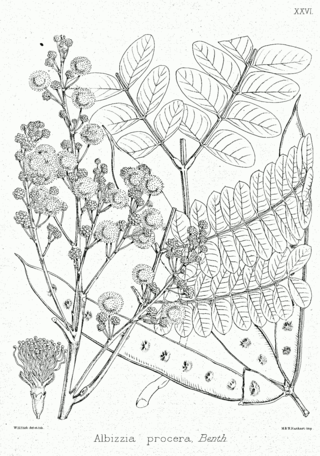
Fagraea berteroana, commonly known as the pua keni keni, pua kenikeni or perfume flower tree, is a small spreading tree or a large shrub which grows in the sub-tropics, where temperatures are 10 °C or more. It is indigenous to the Samoa Islands where it is known as the pua-lulu plus in Tonga and Tahiti as pua. Its occurrence spans from New Caledonia to eastern Polynesia. The ITIS database clarifies the spelling of the name.

Gomortega keule is a tree native to Chile. It is the sole species of the genus Gomortega and, according to the APG IV system of 2016, of the monotypic family Gomortegaceae, assigned to the order Laurales in the clade magnoliids.

Pseudalbizzia inundata is a perennial tree native to South America. Common names include maloxo, muqum, paloflojo, timbo blanco, timbo-ata, and also "canafistula" though this usually refers Cassia fistula.
Pseudalbizzia buntingii is a species of plant in the family Fabaceae. It a tree found only in Zulia state of Venezuela.
Pseudalbizzia burkartiana is a species of tree in the family Fabaceae.
Pithecellobium decandrum is a species of flowering plant in the legume family, Fabaceae. It is endemic to Brazil, where it occurs in the forests of the Amazon River valley and along its tributaries.
Pseudalbizzia edwallii is a species of plant in the family Fabaceae. It is native to northeastern Argentina and southeastern and southern Brazil.
Pseudalbizzia glabripetala is a species of flowering plant in the family Fabaceae. It is a tree native to Guyana, Venezuela, and Roraima state of northern Brazil.
Parasenegalia vogeliana is a species of flowering plant in the family Fabaceae. It is a liana native to Hispaniola, Puerto Rico, and the Lesser Antilles.
Albizia obbiadensis is a species of plant in the family Fabaceae. It is found only in Somalia.
Pseudalbizzia pistaciifolia is a species of plant in the family Fabaceae. It is found in Colombia, Ecuador, and Venezuela.
Albizia suluensis, the Zulu albizia, is a species of plant in the family Fabaceae. It is found only in South Africa. It is threatened by habitat loss.
Chloroleucon foliolosum is a tree species in the legume family (Fabaceae). It is found in Argentina, Brazil and Bolivia.

Sonchus berteroanus, synonym Dendroseris berteroana, is a species of flowering plant in the family Asteraceae. It is found only in the Juan Fernández Islands of Chile. It is threatened by habitat loss.
Albizia ferruginea is a species of plant in the family Fabaceae. It is found in Angola, Benin, Burkina Faso, Cameroon, Central African Republic, the Republic of the Congo, the Democratic Republic of the Congo, Ivory Coast, Gabon, Gambia, Ghana, Guinea, Guinea-Bissau, Nigeria, Senegal, Sierra Leone, Togo, and Uganda. It is threatened by deforestation.
Abarema alexandri is a species of plant of the genus Abarema in the family Fabaceae. It is endemic to Jamaica, where it can be found in woodland or thicket on limestone soils.
Sloanea berteroana is a tree of the Caribbean region. The name is often misspelled as Sloanea berteriana. Its vernacular names include montillo and bullwood. It is native to Puerto Rico. This tree is common in the Toro Negro State Forest.
Pseudalbizzia is a genus of flowering plants in the pea family (Fabaceae). It includes 17 species which are native to the tropical Americas, from Mexico to northern Argentina.

Albizia procera, commonly known as white siris or karoi tree, is a species of large tree found natively in southeast Asia and India. It is most commonly found in open forests, but may also be found on the margins of rain forests and in monsoon and gallery forests. It is considered an invasive species in South Africa.





